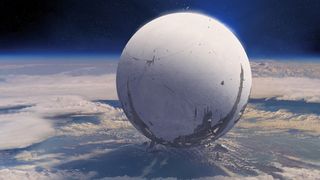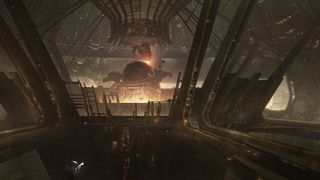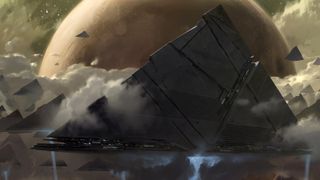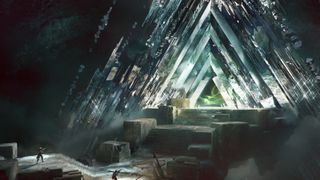What Destiny 2's lore suggests about the future of Bungie's MMO shooter
Deciphering the next steps for Destiny.

The arrival of Destiny 2 on PC will, inevitably, change the way the story of Bungie's MMO is told. In its first, console-bound iteration, uncovering Destiny's secrets meant a slow process of investigation and exploration—endless theorising about lore and level design, poking at the corners of every environment in search of clues. Although some data mining did occur back then, the presence of Destiny 2 on PC makes more substantial leaks a fact of life: something Bungie will need to have a plan for unless they want the story of their game to be told through Reddit threads and spoilerific YouTube thumbnails.
Even so, there's merit in taking Destiny 2 as it comes: and even if you're committed to digging through the game's files, making sense of what you find means understanding the context of Destiny's story so far. With that in mind, this article is intended to get you up to speed on some of the headier elements of Destiny's lore—the stuff that is likely to shape the game in the months and years to come. If you're tooling about in Destiny 2's endgame trying to figure out what it all means, hopefully this will help kickstart your own investigation into Bungie's surprisingly deep sci-fi universe.
Needless to say, spoilers follow: if you haven't completed Destiny 2's campaign yet, go do that and come back when you have. Some of this also concerns PvP content that hasn't arrived on PC yet—just so you know.
Seriously! Spoilers are coming after this point.

The Darkness is triangles
Back in April, while I was writing my first guide to Destiny's lore for PC players, I did my best to explain the Darkness—the series' mysterious and unrevealed cosmic antagonist. Here's what I wrote:
"The easiest way to understand it is that the Darkness is the opposite of the Traveler. The Traveler is a singular point of light—the Darkness is a vast void. The Traveler is physical, the Darkness is immaterial. The Traveler creates and elevates, the Darkness consumes and homogenises."
Well, reader, I've got some news. There is a decent chance that the Darkness is not, in fact, a conceptual cosmic force or an existential crisis being experienced by a very big golfball. It may, in fact, be some triangles.
The biggest gaming news, reviews and hardware deals
Keep up to date with the most important stories and the best deals, as picked by the PC Gamer team.
Specifically, these triangles.

At the end of Destiny 2's campaign, the Traveler—for the first time—does something. Its awakening takes the form of an explosion of Light that breaks its shackles and expands throughout our solar system before forming a sort of galactic 'ping'. That ping is received by dark, angular spacecraft waiting in dormant in intergalactic space, who immediately turn and begin to move towards the source of the shockwave. Needless to say, this is very unlikely to be a good thing—it likely means that Destiny's long-awaited fifth alien race is on its way.
That this new foe represents the Darkness itself is heavily implied at the beginning of the game, where the Ghost's description of the Darkness' first attack on humanity is accompanied by an ominous triangular shadow passing over the surface of the Traveler. Similar shapes can also be seen during the vision sequence that occurs after you lose your powers.
It's unclear if the Darkness has itself been empowered by the Traveler's rebirth or if it is simply picking up a pursuit that had gone cold. Early in the first game the Darkness was described as the Traveler's 'pursuer', and that is reflected here. There's a chance that the Traveler's dormant state had shielded it from the enemy prior to this moment.
The weakness with this theory, however, is that the Darkness clearly knew where the Traveler was: it has attacked Earth before, and players destroyed a big ol' piece of it at the conclusion of the first game. This could be taken as evidence that what we're seeing is, once again, not the Darkness but another of its agents. It could also indicate that the Darkness responds to not the Traveler specifically, but to the use of the Traveler's power: a more exciting suggestion that plays to the idea that the Darkness acts to balance out the Light. A dormant Traveler wouldn't need 'balancing', after all.
Osiris and the outcasts
Despite all this, it doesn't look like we're going to get answers about the exact nature of the Darkness straight away. Destiny 2's first expansion, formally revealed this week, concerns Osiris: an enigmatic figure from the first game's lore, a former Warlock of the Tower obsessed with the Vex who vanished into the machines' network on Mercury some time ago. Osiris, we were told, is 'alive and dead' at the same time. In hindsight, I suppose, all Guardians are.
In any case, he's back—and a central figure in December's new mini-campaign. In pitting him against the time-traveling Vex, Bungie are positioning him as a counterpart to the Hive-obsessed Eris Morn—another lost Guardian who showed up in an end-of-year expansion to lead the Guardians against a new threat.
That link is worth considering. Eris herself has vanished since the first game, and she was revealed to be reporting to Osiris in The Taken King. Gradually, a picture is forming of a network of outcast Guardians, each drawn to study a different foe, whose threads may converge with Osiris. While his focus has traditionally been on the Vex, he seems to understand the Hive and is said to have brokered deals with both the Awoken Queen (wherever she's gone) and The Nine. He was also, at one point, a major figure within the Vanguard and an apprentice to the Speaker himself—a position now notably vacant.
Despite his exile, Osiris might be key to understanding the links between all of Destiny's enemies—and if he's paying closest attention to the Vex, then that suggests that they've got an as-yet-unrevealed part to play in the game's unfolding cosmic drama. They're not the only ones, it seems.
The Nine
This enigmatic faction made itself known in Destiny 1 through Xur, the hooded stranger who shows up on weekends to sell gear to Exotic-hungry Guardians. In Destiny 2, Xur is joined by another Agent of the Nine—The Emissary. She oversees the Trials of the Nine, an endgame PVP event that will be arriving on PC soon.
The Trials are functionally the equivalent of Destiny 1's Trials of Osiris. That connection in and of itself is interesting, because while Osiris is most commonly associated with the Vex, the number 9 occurs frequently in connection to him. It may well be that the Trials of Osiris were intended to prepare Guardians for judgement by the Nine—that this is the test that Osiris wanted players to be ready for.
That's supposition, however. What is known is that we still haven't, truly, met the Nine: just their agents, and what appears to be an interstellar meeting point where contact can be made. Winning a game in Trials unlocks access to the Third Spire, a strange social area that appears to be inside a black hole—it's certainly feels more like a pocket dimension than a planet. The more games you win, the higher up the Spire you can climb, with the Emissary elaborating more upon her role as you go. She's there to judge you, to test your relationship with death, and to gauge your willingness to pursue perfection. This is probably the point where you should start paying attention to numbers, by the way.
Achieve a flawless run (seven wins without dropping a game) and you can leap through a portal to a place beyond the Spire where the Emissary addresses you again, this time massive and holding what looks like a golden planet. She's surrounded by a vast starfield, you're standing in what appears to be water, and there's a celestial space horse behind you. No, I'm not entirely sure what the horse means either.
Superficially, what we've seen of The Nine sets them apart from every other Destiny faction. However, I suspect that they're going to be an increasingly important part of the game's future, and that they may have deep ties to both the Traveler and the Darkness—they may even be the Darkness, reaching out to us in its own way. The best argument for this is based on the similarity between the Emissary's various speeches in the Third Spire and Hive philosophy. Her meditations on judgement, death, perfection, and the need to continually defeat foes to survive—an idea built into the mechanics of the Trials themselves—is very close to Hive Sword Logic (see April's article, again, for more on that.)
Does that mean that The Nine are the Hive? No. However the journey you undertake to get to the Third Spire—plunging into a black hole—bears similarities to the journey that the Hive god Oryx undertook to meet his own mysterious patron-gods in the Deep. The Third Spire itself—and the cosmic dimension beyond it—bear similarities to Hive 'throne worlds', a power that stems from the bargain that Oryx made. And the Emissary's final, gigantic appearance only has one parallel in Destiny so far—and that's Oryx, during the final battle in his throne world in Destiny 1, where he appears in much the same way. Players have long suspected that Oryx's powers—including the ability to create Taken—came directly from the Darkness. Perhaps the same is true of the Nine. In any case, don't be surprised if we hear a lot more from them in the time it takes for those mysterious space pyramids to arrive.

Triangles, again
Bound up in Destiny 2's endgame, then, is a set of tantalising implied links between The Nine, The Hive, and—through Osiris—the Vex. These are, conveniently, all of Destiny's most enigmatic alien forces. And what do they have in common? You better believe it's triangles!
From Vex iconography to the hierarchies of the three gods of the three-eyed Hive (literally a pyramid scheme for harvesting light) it may be that the key signifier of the Darkness has been sitting in front of us the entire time. Bungie have always loved this kind of numerology—it features heavily in the Halo series—so it's not a stretch to go pattern-hunting in this way.
If those mysterious pyramid ships mean anything, then, it's that everybody who went hunting for meaning in the first game's lore and iconography was probably onto something. Knowing Bungie, that means there's likely more to find: those ominous space triangles are as much a clue to what's already there as a sign of what's coming next.
Joining in 2011, Chris made his start with PC Gamer turning beautiful trees into magazines, first as a writer and later as deputy editor. Once PCG's reluctant MMO champion , his discovery of Dota 2 in 2012 led him to much darker, stranger places. In 2015, Chris became the editor of PC Gamer Pro, overseeing our online coverage of competitive gaming and esports. He left in 2017, and can be now found making games and recording the Crate & Crowbar podcast.
Most Popular


